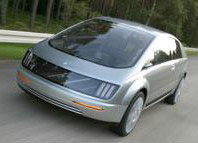Honda’s Green Car
Air Date: Week of February 7, 2003
Living on Earth’s Ingrid Lobet talks with Robert Bienenfeld, a senior product manager with American Honda about the company’s fuel cell vehicle now being tested in Los Angeles.
Transcript
CURWOOD: And now to California, where some of the first fuel cell technology is already on the road. Japanese automakers Toyota and Honda delivered a handful of fuel cell cars to the University of California and the City of Los Angeles last December to test in everyday driving.
 |
 |
|
| Honda FCX Fuel Cell Vehicle | GM’s Hy-wire Fuel Cell Vehicle
Southern California already has at least eight hydrogen filling stations. And a dozen more are in the works. The H2 mobiles are in high demand these days. But, Living on Earth's Ingrid Lobet caught up with one Honda FCX, and with Robert Bienenfeld, senior manager for American Honda product planning, to talk about the fuel cell future.
BIENENFELD: Why don't we pop the hood? LOBET: So, I don't see anything I recognize; no cylinders, no distributor cap, no battery, no spark plugs. Can you tell us how it works? BIENENFELD: Sure. Here, what we have is an electrochemical reaction where we mix hydrogen and the oxygen in air together. And, chemically, we create electricity. And the exhaust is just water vapor. LOBET: Now, the President said in his State of the Union Address last week, that it was his hope that a child born now could have, as his or her first vehicle, a fuel cell car. That's 16 years away. Do we have to wait that long to buy one of these? BIENENFELD: Well, we think that's actually a good estimate. And there are a lot of hurdles to overcome for mass production and making it available in a showroom. Hurdles like the infrastructure issues. How do you make hydrogen cleanly? And, how do you distribute it to consumers? LOBET: Can you see a day in the near, the foreseeable, future when you might be able to sell one for 20, $25,000 dollars? BIENENFELD: Well, of course, that's our dream. And, we're taking several steps to achieve that dream. And it's not just building a fuel cell vehicle powered by hydrogen. It's also working with clean gasoline vehicles. Because clean gasoline vehicles teach us about catalyst technology. Catalysts are core technologies for fuel cells. LOBET: We know that hydrogen doesn't just occur out here in the atmosphere or on the Earth the way we might wish that it did. We have to use energy either from nuclear plants, or coal, or perhaps the sun, to separate it from other molecules. How are you getting the hydrogen that's running this vehicle? BIENENFELD: Well, this vehicle is being fueled at a station which is taking photovoltaic technology and converting sunlight into electricity. The production of hydrogen is one of the key issues. After all, if we don't make hydrogen cleanly, we haven't really accomplished a lot. Fuel cells, depending how we make the hydrogen, can be clean, can be an improvement in CO2. But they absolutely are a solution for fuel because we can make the fuel from a number of sources; grasses, making grasses into ethanol, ethanol into hydrogen, many different ways we can do it. And that's what's being researched now. LOBET: Switching away from the internal combustion engine is going to be such a shift for the American psyche. What are your plans for helping Americans make that shift? BIENENFELD: I think, while Americans have a great love affair with automobiles, what they really crave is mobility. We know how people respond to horsepower, and torque, and all the little amenities on a car, and the packaging. But, these are really new and exciting areas to explore. For example, with an electric vehicle like a hydrogen fuel cell vehicle, they can operate in a much more quiet environment. How do people value that? If you don't go to a gas station, if you could refuel at home, how do people respond to that? Is that a value? In the United States, the value of our time in going to a gasoline station may far outweigh the cost of the fuel. So, by making these baby steps, we can learn a lot about what will drive consumer behavior in the future, and how we can successfully launch hydrogen fuel cell vehicles. CURWOOD: Robert Bienenfeld, senior manager for American Honda product planning, speaking with Living on Earth's Ingrid Lobet in Los Angeles. You can see photos of the Honda FCX and other fuel cell vehicles on our website. That's loe.org. Living on Earth wants to hear from you!Living on Earth Newsletter [Click here]
Donate to Living on Earth! NewsletterLiving on Earth offers a weekly delivery of the show's rundown to your mailbox. Sign up for our newsletter today!
|





